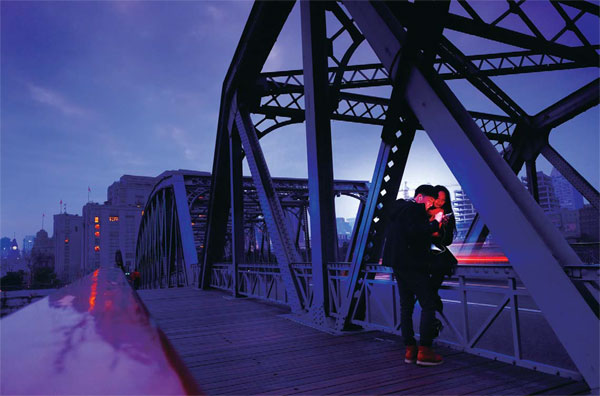Search This Supplers Products:steel pipeBossen steel tubeBossen steel plankBossen steel coilBossen scaffoldingBossen steel sheet
Celebrating the bridges of Suzhou Creek
sourceWebside
publisherEllie Dong
time2016/07/08
- Celebrating the bridges of Suzhou Creek
Apart from being vital transport infrastructure, the many crossings over Shanghai's most famous waterway are also icons in their own right
Suzhou Creek, a virtual museum of bridges because of the many structures built across it over the years, soon will get an addition to its collection.
The Shanghai government recently announced that a new Changping Road Bridge will be built in the area of Shanghai Railway Station to alleviate traffic congestion caused by a boom in vehicles. Seven bridges already are located roughly 480 meters apart from one another in the busy area.
Waibaidu Bridge, a city icon, is a popular meeting place for couples. Photos by Gao Erqiang / China Daily |
Fujian Bridge: First built in 1875, this has been dubbed Laozha Bridge, or Old Gate Bridge. Zhejiang Bridge: Locals call this the "garbage bridge" as residents used to dump rubbish at a site nearby. |
Construction of modern bridges over Suzhou Creek began about a century and a half ago. The waterway snakes 17 km westward from downtown Shanghai and links the municipality with the city of Suzhou as well as other inland cities in Jiangsu province.
Most of the bridges along the eastern side of the creek were built before the 1940s and incorporated European elements. Those along the creek's western stretches were introduced as the city started expanding.
The most famous of the bridges is arguably Waibaidu Bridge, or the Garden Bridge, situated at the confluence of the Huangpu River and Suzhou Creek. The bridge, having been around for more than 140 years, often is seen in movies and promotional posters for Shanghai.
Numerous tour buses stop daily near the bridge, the starting point of the former foreign concessions in the city. Wooden flooring on both sides of the bridge serves as an observation deck for tourists. From this point, people can enjoy the view of historic buildings along the Bund, the narrow and old streets behind the waterfront, and the breathtaking skyline of the Lujiazui financial district across the Huangpu River.

The bridge is itself a marvel to behold. Come nightfall, colorful neon lights illuminate the structure, turning it from a mere transportation tool to a romantic spot. Couples can often be spotted having wedding photos taken at the bridge. The more adventurous ones scamper onto the center of the road when there is a lull in traffic.
In 1856, the Wells Bridge was built over Suzhou Creek, but it was barely utilized after locals complained about toll charges. When a toll-free bridge was built 17 years later, people called it Waibaidu, which means "going across for free" in Mandarin and Shanghainese. This wooden bridge was then refurbished as a steel truss structure in 1907.
It is a tradition in Shanghai for a grandmother to carry her month-old grandchild across the bridge to symbolize that the newborn has left behind twists and turns, and will hence be able to get through life safely and smoothly.
"Waibaidu Bridge is a Shanghai icon. When my daughter was a baby she had a photo taken there with her grandmother, too. It's been a family tradition for us to do so," says Shanghai native Wang Xuefen.
In 2007, Howarth Erskine Co Ltd, the British company that designed the Waibaidu Bridge, reminded the authority in Shanghai that the bridge had reached its service limit of 100 years. About a year later, the bridge underwent a major overhaul as workers took it apart and sent the components to Shanghai Shipyard.
According to Hu, 215 metric tons of steel parts were replaced and 63,000 rivets, which accounted for 40 percent of those on the original structure, were replaced.
"The renovation was carried out according to the original design of the bridge by the British company and we did our best to restore the historic bridge to its initial state. Before the replacements took place, our workers carefully studied the chemical and mechanical components of the steel on the bridge and searched for the best replacements," says Hu, adding that the new structure will another require renovation in half a century.
Wang Changfeng, a 59-year-old Shanghai native, says engineers have done a great job giving the bridge a new lease on life.

"It looks no different from what it was during my childhood. The bridge used to creak when heavy motor cars went across, but now that noise is gone," he says.
Similarly, Zhejiang Road Bridge, which is next to Waibaidu and has been standing for more than a century, underwent repairs and restoration in 2015. A temporary repair plant was set up on the north bank of the creek for the project.
A large-scale renovation project involving 17 other bridges along Suzhou Creek also started in 2009. The facade of each bridge was repainted and some walls and lights were given a cameo treatment to spruce up the atmosphere around the bridge.
"The renovation of a bridge may cost more than 100 million yuan ($15 million; 13.5 million euros), but it is a worthy investment, not just because it is an upgrade in traffic infrastructure, but because it also helps in the continuation of historical and cultural features of Shanghai. In terms of heritage, each of the bridges is priceless," says Lin Xiang, Party chief of Shanghai Municipal Investment (Group) Corp.
Aside from its bridges, Suzhou Creek is also, unfortunately, known for its stench. The creek, once an important mode for transportation of goods, was beset about a century ago with pollution from textile mills, chemical plants and other factories in the Zhongshan Park area.
"Suzhou Creek has always been associated with smelliness and pollution. My friend and I used to go to the riverbank to watch the waste flowing out from the chemical plants when I was a little girl. We didn't know it was pollution. We thought it was a red waterfall," says Huang Qi, 59.
The city government finally decided to clean up the creek in the 1990s, relocating all the plants and introducing riverside parks, yacht clubs as well as tall residential and office buildings. Today, the area is a popular place for a scenic stroll. In the past decade, two more bridges have been built in that area to improve human and vehicular traffic. Overpasses were also built at several intersections for people to enjoy the view of the creek.


